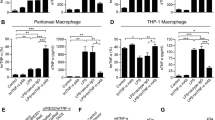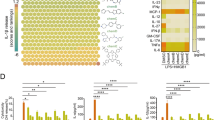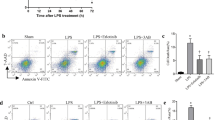Abstract
Identification of new therapeutic targets for the management of septic shock remains imperative as all investigational therapies, including anti-tumor necrosis factor (TNF) and anti-interleukin (IL)-1 agents, have uniformly failed to lower the mortality of critically ill patients with severe sepsis. We report here that macrophage migration inhibitory factor (MIF) is a critical mediator of septic shock. High concentrations of MIF were detected in the peritoneal exudate fluid and in the systemic circulation of mice with bacterial peritonitis. Experiments performed in TNFα knockout mice allowed a direct evaluation of the part played by MIF in sepsis in the absence of this pivotal cytokine of inflammation. Anti-MIF antibody protected TNFα knockout from lethal peritonitis induced by cecal ligation and puncture (CLP), providing evidence of an intrinsic contribution of MIF to the pathogenesis of sepsis. Anti-MIF antibody also protected normal mice from lethal peritonitis induced by both CLP and Escherichia coli, even when treatment was started up to 8 hours after CLP. Conversely, co-injection of recombinant MIF and E. coli markedly increased the lethality of peritonitis. Finally, high concentrations of MIF were detected in the plasma of patients with severe sepsis or septic shock. These studies define a critical part for MIF in the pathogenesis of septic shock and identify a new target for therapeutic intervention.
This is a preview of subscription content, access via your institution
Access options
Subscribe to this journal
Receive 12 print issues and online access
$209.00 per year
only $17.42 per issue
Buy this article
- Purchase on Springer Link
- Instant access to full article PDF
Prices may be subject to local taxes which are calculated during checkout






Similar content being viewed by others
References
Glauser, M. P., Zanetti, G., Baumgartner, J. D. & Cohen, J. Septic shock: pathogenesis. Lancet 338, 732–736 (1991).
Abraham, E. Why immunomodulatory therapies have not worked in sepsis? Intensive Care Med. 25, 556–566 ( 1999).
Bloom, B. R. & Bennett, B. Mechanism of a reaction in vitro associated with delayed-type hypersensitivity. Science 153, 80–82 (1966).
David, J. Delayed hypersensitivity in vitro: its mediation by cell-free substances formed by lymphoid cell-antigen interaction. Proc.Natl.Acad.Sci.USA 56, 72–77 ( 1966).
Nathan, C. F., Remold, H. G. & David, J.R. Characterization of a lymphocyte factor which alters macrophage function. J. Exp. Med. 137, 275 –288 (1973).
Nathan, C. F., Karnovsky, M. L. & David, J.R. Alterations of macrophage functions by mediators from lymphocytes. J. Exp. Med. 133, 1356– 1376 (1971).
Bernhagen, J. et al. MIF is a pituitary-derived cytokine that potentiates lethal endotoxaemia. Nature 365, 756– 759 (1993).
Calandra, T. et al. MIF as a glucocorticoid-induced modulator of cytokine production . Nature 377, 68–71 (1995).
Calandra, T., Spiegel, L. A., Metz, C. N. & Bucala, R. Macrophage migration inhibitory factor (MIF) is a critical mediator of the activation of immune cells by exotoxins of Gram-positive bacteria. Proc.Natl.Acad.Sci.USA 95, 11383–11388 (1998).
Calandra, T., Bernhagen, J., Mitchell, R. A. & Bucala, R. The macrophage is an important and previously unrecognized source of macrophage migration inhibitory factor. J. Exp. Med. 179, 1895–1902 (1994).
Bernhagen, J. et al. Purification, bioactivity, and secondary structure analysis of mouse and human macrophage migration inhibitory factor (MIF). Biochemistry 33, 14144–14155 (1994).
Bacher, M. et al. An essential regulatory role for macrophage migration inhibitory factor in T-cell activation. Proc. Natl. Acad. Sci. USA 93, 7849–7854 (1996).
Mitchell, R. A., Metz, C. N., Peng, T. & Bucala, R. Sustained mitogen-activated protein kinase (MAPK) and cytoplasmic phopholipase A2 activation by macrophage migration inhibitory factor (MIF). J.Biol.Chem. 274 , 18100–18106 (1999).
Lan, H.Y. et al. The pathogenic role of macrophage migration inhibitory factor in immunologically induced kidney disease in the rat. J. Exp. Med. 185, 1455–1465 ( 1997).
Mikulowska, A., Metz, C. N., Bucala, R. & Holmdahl, R. Macrophage migration inhibitory factor is involved in the pathogenesis of collagen type II-induced arthritis in mice. J. Immunol. 158, 5514 –5517 (1997).
Leech, M. et al. Involvement of macrophage migration inhibitory factor in the evolution of rat adjuvant arthritis. Arthritis Rheum. 41, 910–917 (1998).
Lan, H. Y. et al. Macrophage migration inhibitory factor expression in human renal allograft rejection. Transplantation 16, 1465–1471 (1998).
Donnelly, S. C. et al. Regulatory role for macrophage migration inhibitory factor in acute respiratory distress syndrome. Nat. Med. 3 , 320–323 (1997).
Bacher, M. et al. MIF expression in experimentally-induced endotoxemia. Am. J. Pathol. 150, 235–246 (1997).
Bozza, M. et al. Targeted disruption of migration inhibitory factor gene reveals its critical role in sepsis. J. Exp. Med. 189, 341–346 (1999).
Marschall, J. C. & Creery, D. Pre-clinical models of sepsis. Sepsis 2, 187– 197 (1998).
Cohen, J. & Abraham, E. Microbiologic findings and correlations with serum tumor necrosis factor-α in patients with severe sepsis and septic shock. J. Infect. Dis. 180, 116– 121 (1999).
Friedman, G., Silva, E. & Vincent, J.L. Has the mortality of septic shock changed with time? Crit. Care Med. 26, 2078– 2086 (1998).
Zanetti, G. et al. Cytokine production after intravenous or peritoneal gram-negative bacterial challenge in mice. Comparative protective efficacy of antibodies to tumor necrosis factor-α and to lipopolysaccharide. J. Immunol. 148, 1890–1897 (1992).
Echtenacher, B., Falk, W., Männel, D. N. & Krammer, P.H. Requirement of endogenous tumor necrosis factor/cachectin for recovery from experimental peritonitis. J. Immunol. 145, 3762–3766 (1990).
Heumann, D. et al. Contribution of TNF/TNF receptor and of Fas ligand to toxicity in murine models of endotoxemia and bacterial peritonitis. J. Inflamm. 47, 173–179 ( 1999).
American College of Chest Physicians/Society of Critical Care Medicine Consensus Conference. Definitions for sepsis and organ failure and guidelines for the use of innovative therapies in sepsis. Crit. Care Med. 20, 864–874 (1992).
Bagby, G. J., Plessala, K. J., Wilson, L. A., Thompson, K. J. & Nelson, S. Divergent efficacy of antibody to tumor necrosis factor-α in intravascular and peritonitis models of sepsis. J. Infect. Dis. 163, 83 –88 (1991).
Wang, H. et al. HMG-1 as a late mediator of endotoxin lethality in mice. Science 285, 248–251 ( 1999).
Maurer, M. et al. The c-kit ligand, stem cell factor, can enhance innate immunity through effects on mast cells. J. Exp. Med. 188, 2343–2348 (1991).
Pfeffer, K. et al. Mice deficient for the 55kd tumor necrosis factor receptor are resistant to endotoxic shock, yet succumb to L. monocytogenes infection . Cell 73, 457–467 (1993).
Rothe, J. et al. Mice lacking the tumor necrosis factor receptor 1 are resistant to TNF-mediated toxicity but highly susceptible to infection by Listeria monocytogenes. Nature 364, 798– 802 (1993).
Porat, R., Clark, B. D., Wolff, S. M. & Dinarello, C.A. Enhancement of growth of virulent strains of Escherichia coli by interleukin-1 . Science 254, 430–432 (1991).
Pasparakis, M., Alexopoulou, L., Episkopou, V. & Kollias, G. Immune and inflammatory responses in TNFα-deficient mice: a critical requirement for TNFα in the formation of primary B cell follicles, follicular dendritic cell networks and germinal centers, and in the maturation of the humoral immune response. J. Exp. Med. 184, 1397–1411 (1996).
Baumgartner, J. D. et al. Association between protective efficacy of anti-lipopolysaccharide (LPS) antibodies and suppression of LPS-induced tumor necrosis factor α and interleukin 6. Comparison of O side chain-specific antibodies with core LPS antibodies. J. Exp. Med. 171, 889– 896 (1990).
Kohler, J. et al. IFN-gamma involvement in the severity of Gram-negative infections in mice. J. Immunol. 151, 916– 921 (1993).
Acknowledgements
We thank M. Knaup and S. Rossier for technical assistance, and T. Roger and P. Majcherczyk for critical reading of the manuscript.This work was supported by grants from the Swiss National Science Foundation to T.C. and to J.P., and by grants from the BMBF to D.M., and from the National Institutes of Health to R.B. T.C. is recipient of a career award from the Swiss National Science Foundation. M.P.G. is recipient of a career award from the Bristol-Myers Squibb Foundation. J.P. is the recipient of a fellowship from the Prof. Dr. Max Cloetta Foundation.
Author information
Authors and Affiliations
Corresponding author
Rights and permissions
About this article
Cite this article
Calandra, T., Echtenacher, B., Roy, D. et al. Protection from septic shock by neutralization of macrophage migration inhibitory factor. Nat Med 6, 164–170 (2000). https://doi.org/10.1038/72262
Received:
Accepted:
Issue Date:
DOI: https://doi.org/10.1038/72262
This article is cited by
-
Distinct patterns of serum and urine macrophage migration inhibitory factor kinetics predict death in sepsis: a prospective, observational clinical study
Scientific Reports (2023)
-
Macrophage migration inhibitory factor is overproduced through EGR1 in TET2low resting monocytes
Communications Biology (2022)
-
Individual responsiveness of macrophage migration inhibitory factor predicts long-term cognitive impairment after bacterial meningitis
Acta Neuropathologica Communications (2021)
-
Pleural cytokines MIF and MIP-3α as novel biomarkers for complicated parapneumonic effusions and empyema
Scientific Reports (2021)
-
Role of macrophages in fetal development and perinatal disorders
Pediatric Research (2021)



